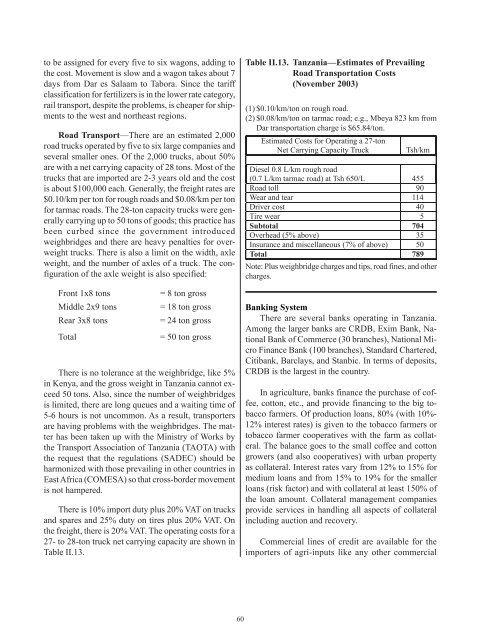An Action Plan for Developing Agricultural Input Markets in Tanzania
An Action Plan for Developing Agricultural Input Markets in Tanzania
An Action Plan for Developing Agricultural Input Markets in Tanzania
Create successful ePaper yourself
Turn your PDF publications into a flip-book with our unique Google optimized e-Paper software.
to be assigned <strong>for</strong> every five to six wagons, add<strong>in</strong>g to<br />
the cost. Movement is slow and a wagon takes about 7<br />
days from Dar es Salaam to Tabora. S<strong>in</strong>ce the tariff<br />
classification <strong>for</strong> fertilizers is <strong>in</strong> the lower rate category,<br />
rail transport, despite the problems, is cheaper <strong>for</strong> shipments<br />
to the west and northeast regions.<br />
Road Transport—There are an estimated 2,000<br />
road trucks operated by five to six large companies and<br />
several smaller ones. Of the 2,000 trucks, about 50%<br />
are with a net carry<strong>in</strong>g capacity of 28 tons. Most of the<br />
trucks that are imported are 2-3 years old and the cost<br />
is about $100,000 each. Generally, the freight rates are<br />
$0.10/km per ton <strong>for</strong> rough roads and $0.08/km per ton<br />
<strong>for</strong> tarmac roads. The 28-ton capacity trucks were generally<br />
carry<strong>in</strong>g up to 50 tons of goods; this practice has<br />
been curbed s<strong>in</strong>ce the government <strong>in</strong>troduced<br />
weighbridges and there are heavy penalties <strong>for</strong> overweight<br />
trucks. There is also a limit on the width, axle<br />
weight, and the number of axles of a truck. The configuration<br />
of the axle weight is also specified:<br />
Front 1x8 tons = 8 ton gross<br />
Middle 2x9 tons = 18 ton gross<br />
Rear 3x8 tons = 24 ton gross<br />
Total = 50 ton gross<br />
There is no tolerance at the weighbridge, like 5%<br />
<strong>in</strong> Kenya, and the gross weight <strong>in</strong> <strong>Tanzania</strong> cannot exceed<br />
50 tons. Also, s<strong>in</strong>ce the number of weighbridges<br />
is limited, there are long queues and a wait<strong>in</strong>g time of<br />
5-6 hours is not uncommon. As a result, transporters<br />
are hav<strong>in</strong>g problems with the weighbridges. The matter<br />
has been taken up with the M<strong>in</strong>istry of Works by<br />
the Transport Association of <strong>Tanzania</strong> (TAOTA) with<br />
the request that the regulations (SADEC) should be<br />
harmonized with those prevail<strong>in</strong>g <strong>in</strong> other countries <strong>in</strong><br />
East Africa (COMESA) so that cross-border movement<br />
is not hampered.<br />
There is 10% import duty plus 20% VAT on trucks<br />
and spares and 25% duty on tires plus 20% VAT. On<br />
the freight, there is 20% VAT. The operat<strong>in</strong>g costs <strong>for</strong> a<br />
27- to 28-ton truck net carry<strong>in</strong>g capacity are shown <strong>in</strong><br />
Table II.13.<br />
60<br />
Table II.13. <strong>Tanzania</strong>—Estimates of Prevail<strong>in</strong>g<br />
Road Transportation Costs<br />
(November 2003)<br />
(1) $0.10/km/ton on rough road.<br />
(2) $0.08/km/ton on tarmac road; e.g., Mbeya 823 km from<br />
Dar transportation charge is $65.84/ton.<br />
Note: Plus weighbridge charges and tips, road f<strong>in</strong>es, and other<br />
charges.<br />
Bank<strong>in</strong>g System<br />
There are several banks operat<strong>in</strong>g <strong>in</strong> <strong>Tanzania</strong>.<br />
Among the larger banks are CRDB, Exim Bank, National<br />
Bank of Commerce (30 branches), National Micro<br />
F<strong>in</strong>ance Bank (100 branches), Standard Chartered,<br />
Citibank, Barclays, and Stanbic. In terms of deposits,<br />
CRDB is the largest <strong>in</strong> the country.<br />
In agriculture, banks f<strong>in</strong>ance the purchase of coffee,<br />
cotton, etc., and provide f<strong>in</strong>anc<strong>in</strong>g to the big tobacco<br />
farmers. Of production loans, 80% (with 10%-<br />
12% <strong>in</strong>terest rates) is given to the tobacco farmers or<br />
tobacco farmer cooperatives with the farm as collateral.<br />
The balance goes to the small coffee and cotton<br />
growers (and also cooperatives) with urban property<br />
as collateral. Interest rates vary from 12% to 15% <strong>for</strong><br />
medium loans and from 15% to 19% <strong>for</strong> the smaller<br />
loans (risk factor) and with collateral at least 150% of<br />
the loan amount. Collateral management companies<br />
provide services <strong>in</strong> handl<strong>in</strong>g all aspects of collateral<br />
<strong>in</strong>clud<strong>in</strong>g auction and recovery.<br />
Commercial l<strong>in</strong>es of credit are available <strong>for</strong> the<br />
importers of agri-<strong>in</strong>puts like any other commercial

















